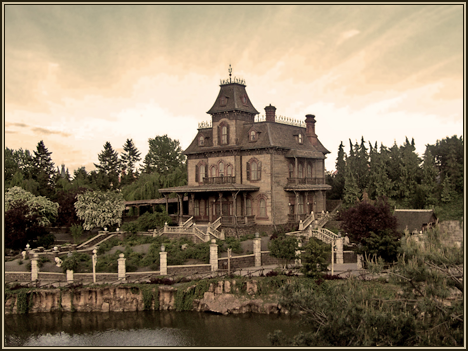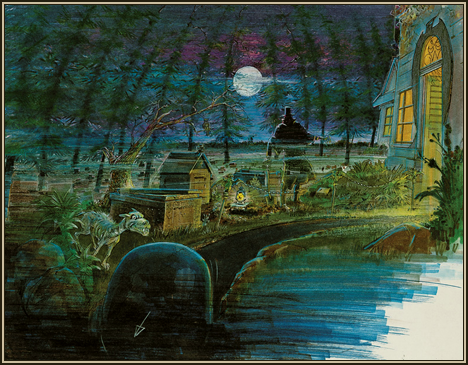

On this page, I’ve tried to give detailed and well-founded answers to questions which repeatedly come up in discussions and e-mails. Where appropriate I’ve complemented my answers with quotes from Imagineers involved in the ride’s creation or with excerpts from official documents.

Q: How does Phantom Manor compare to the other Haunted Mansion attractions?
A: We’ll mention some of the departures that Phantom Manor’s creative team took from the previous versions over on the Making of Phantom Manor pages, but here’s the general idea:

The order of the show scenes remains largely the same, it’s mostly the context that changes. Many of these changes were motivated by the multilingual audience of the European park (replacing the connecting Ghost Host narration by recurring characters, for instance), others by the attraction’s location in Frontierland.
The Haunted Mansion is a retirement home for spirits and ghosts filled with happy haunts from all over the world... Your ghost host accompanies you on your visit, commenting on the ghostly goings-on throughout the dark corridors and spooky halls of the mansion, he rejoins you after leaving the house and traveling through a graveyard full of shimmering spirits singing the theme tune, Grim Grinning Ghosts.
Phantom Manor used to be the home of a gold-rush baron whose daughter was jilted on her wedding day and continued to haunt through the family home ever since. Your host, the sinister Phantom, greets you as you enter and then lets you discover on your own what happened to the Bride after her ruined wedding day. After leaving the house, you descend under the family graveyard and enter the underworld where the Phantom tries to trap you among the spirits of Phantom Canyon. Fortunately, the bride appears in skeletal form and shows you a way out.
Along with the obvious difference in tone comes a different musical underscore. Where the Haunted Mansion charms with otherworldly music rooted in the 1960s, Phantom Manor employs a fully orchestral score that enhances the heights and lows of the dramatic action it accompanies.

Q: Is the Bride actually called Melanie Ravenswood or is that a Cast Member or fan invention?
A: The name Melanie appears on several letters in the Bride’s Boudoir scene. Cast Members and fans took this as a hint that it was the Bride’s first name. By now it has become so widely used that it’s hard to imagine any other name for her, although in fact ours was the first website to share this name with the general public.
But just how official is the name? Current Disneyland Paris Imagineers have been clear that the character’s only correct appellation is “The Bride” and nothing more. At most, a humble “Miss Ravenswood” may be used in connection with the Manor’s backstory.
However, Jason Surrell’s 2003 publication “The Haunted Mansion: From the Magic Kingdom to the Movies” actually did call her by her full name, spreading its use even further and giving it some official weight.
So what about the Imagineers’ original intent during the ride’s creation? Were these letters just hastily crafted props with no connection to the ride’s characters or did they actually reflect the ideas of Jeff Burke and his creative team?
Jeff confirmed the latter for us when asked, with one small word of caution:
“In terms of the names of the Manor’s family members, the patriarch and matriarch are Henry and Martha Ravenswood. Their daughter’s name is indeed Melanie Ravenswood, as indicated by correspondence to be found in the boudoir scene. However, when referring to this character, particularly whenever she’s seen in the lovely white bridal gown, she is simply referred to as the Bride.”


Q: I’ve heard the last scene of Phantom Manor called “Little Leota.” Is it actually supposed to be Madame Leota we see, or is it the Bride?
A: In the Haunted Mansions, this effect has been known as Little Leota, although it was clearly not intended to be the same character as the fortune-teller in her crystal ball. The name was simply given because the special effect and the face seen, that of Leota Toombs, were the same.
For Phantom Manor, the name was kept in backstage documents for clarity’s sake, as everyone would know which effect it referred to. Guests were never meant to see the name, while it was assumed that they would make the connection to the Bride’s other appearances themselves.
Likewise, the girl in the Grand Hall chandelier is called “Egyptian Lady” in early documentation, although there is nothing Egyptian about her – as opposed to her predecessors in the Haunted Mansion.
A WDI ride description from November 1991 intended for maintenance purposes states the following:
“Guests walk up a ramp, passing a miniature image of the Bride (aka Little Leota) (...) who beckons them to hurry back.”

Q: Why does the Phantom’s appearance change so radically between the Graveyard Garden and Phantom Canyon?
A: The Phantom initially appears with an entirely blank skull for a face, but at the end of the ride he’s suddenly covered by decomposed flesh and has piercing eyes.
Much speculation has been made about this transformation: some believed that he had been wearing a mask throughout the first half of the ride, much like the Phantom of the Opera. Others thought that he was re-materializing, becoming once more of flesh and blood, just as the Bride was crossing over into the realm of the Dead.
Certainly both of these interpretations are of merit. The actual motivation behind the change, however, was a bit simpler. Rather than hinting at an elaborate literal transformation, the change is an example of visual storytelling. As Phantom Manor creator Jeff Burke explains:
“The Phantom’s appearance was intended to change from a mysterious, shadowy silhouette figure whose presence was meant as an ominous skulking background persona in the earlier scenes. He then becomes a fully detailed and frightfully intimidating character in the ‘Phantom Canyon’ finale sequence.”


Q: Why does the ride slow down or even stop completely every so often? Can there really be so many technical difficulties?
A: There are a number of possible reasons... The most frequent cause for the ride cycle to stop or slow down is to accommodate disabled guests who would not be able to get into or out of their Doom Buggy in time while the vehicle is traveling at its regular speed. Even a perfectly healthy rider may not manage to enter or exit his carriage within the limits of the moving carpets... What is actually the most rare reason, albeit the one causing the longest interruptions, is a technical problem of some kind. So unless you are actually stopped for more than ten minutes, the cause for your temporary halt is most certainly a fellow visitor.
|

